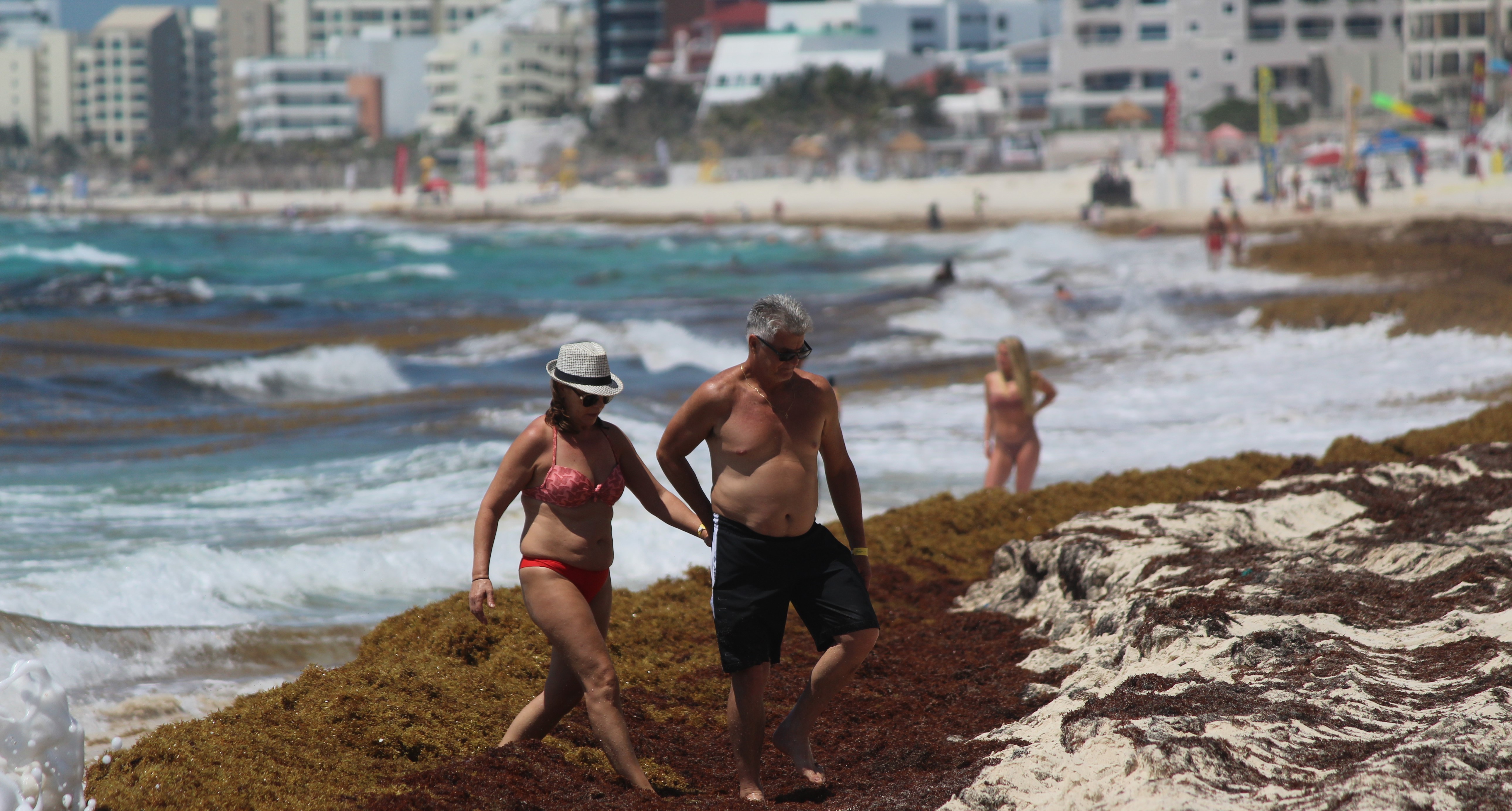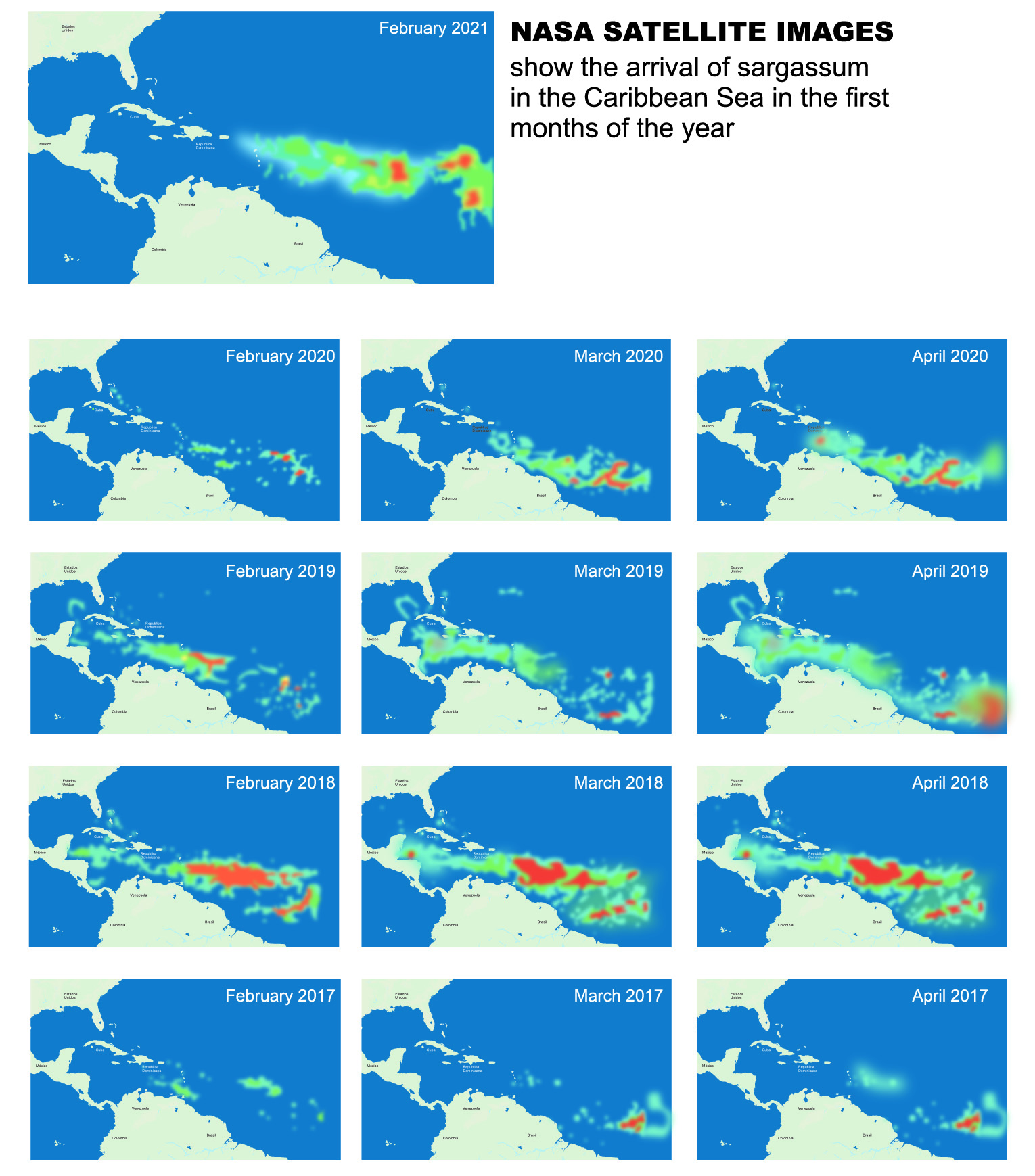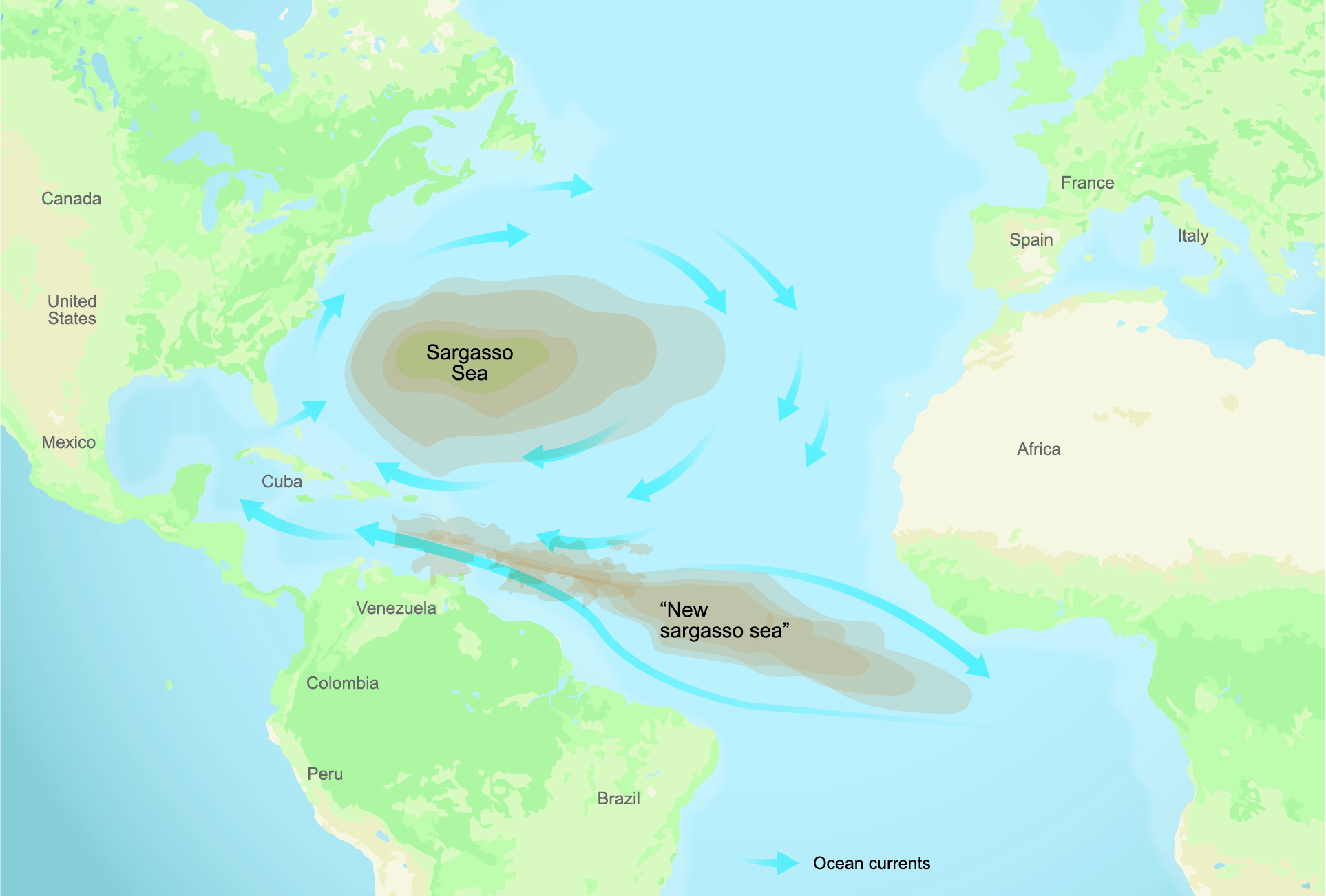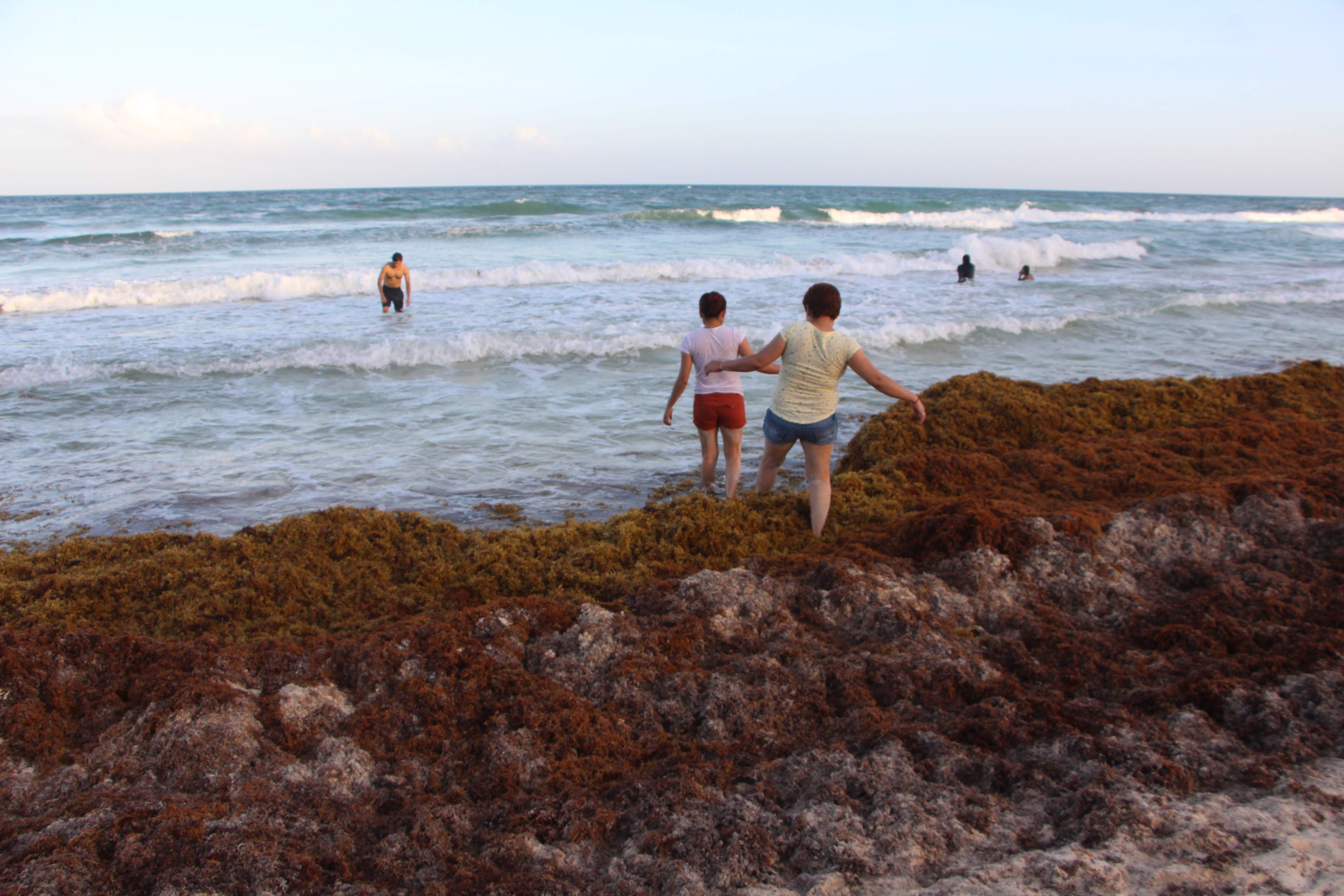A decade after the first sargassum blooms were spotted in the South Atlantic, these massive brown mats of macro-algae represent one of the largest ecological threats to the Caribbean, a megadiverse region whose tens of millions of inhabitants heavily depend on tourism and natural resources.
The coming year looks like it will be particularly bad, scientists are predicting. The floating sargassum bloom has shown accelerated growth since December of 2020, according to satellite monitoring reports that carried out by the University of South Florida jointly with NASA.
“The crisis is coming again for the Caribbean coasts,” warns Alejandro Bravo Quesada, specialist in marine oceanography and the Director of Ocean Solutions Mexico.
According to the reports, the amount of sargassum in the sea went from 3.2 million tons in December to 4.6 million tons in February. This amount is four times higher than reported for the same period in February of last year.
The University report indicates that this amount is comparable to the 2018 and 2019 records, when the brown sargassum tide completely transformed the Caribbean coast of turquoise waters and white sands.

“The sargassum phenomenon has begun to show some behavior patterns since we started to observe it more carefully, in 2015. The blooming season begins early in the year and has its highest peaks in the summer, showing a significant decline in the winter. We see that it has annual periods of greater intensity, then less and it rises again. These patterns indicate that most likely this year we will have large quantities,” explains Bravo Quezada, who is a member of the group of scientists who advise the Mexican state government of Quintana Roo about this phenomenon.
With a current extension of 86 kilometers, the sargassum belt is currently located to the south of the Lesser Antilles, which have already experienced minor landfalls. The dynamics of the maritime currents and the trajectory the floating mats have followed in previous years allow experts to infer that this sargassum would travel through the Caribbean region until it meets the Mexican coasts and then heads to South Florida.

For the last six years, tourists have been welcomed at Caribbean destinations by images of brown water, a foul odor, dead marine fauna and tons of accumulated algae on the coast, especially when sargassum landfall became more intense.
But bad sights and smells are only the tip of the iceberg of an “environmental disaster” at regional level if it is not managed soon, warns Rosa Elisa Rodríguez, a researcher at the National Autonomous University of Mexico (UNAM, by its Spanish acronym) Institute of Limnology and Marine Sciences.
The sargassum piling up on the coasts already impact seagrass meadows, mangroves, reefs and beaches, in addition to representing a threat to the economy of regions that essentially live on tourism, such as Quintana Roo (Mexico), the Dominican Republic, Jamaica, Belize and Aruba, among others.
However there is no agreed figure on the economic consequences about the sargassum arrival in the Caribbean.
During a talk at the University of West Indies, Edmund Bartlett, co-chair at the Global Tourism Resilience and Crisis Management Center, said that the annual cost of cleaning-up the Caribbean islands was around 120 million dollars.
Quintana Roo’s Government reported that in 2018 were removed 522,226 tons of sargassum from the public beaches and coastal zones, which represented an investment of 17 million dollars. For 2019 and 2020 there are no concise figures.
The mentioned amount of money is aside from what each hotel allocates to clean-up its beach-front every day, and this cost could be up to 60 thousand dollars annually for a medium size hotel, according to hotel owners.

Nevertheless, this figure varies over the time, depending on the beach size, its location and sargassum quantity.
Those figures only include cleaning costs without taking into account a possible drop in tourist arrivals.
The environmental and economic impacts have led to a desperate search for solutions from the scientific community and governments in many countries, but have yet to lead to effective actions.
In June of 2019, the first International convention to address the sargassum problem was held in Cancun, Mexico. At this meeting, representatives from 13 Caribbean countries committed to working together through public policies and knowledge production to deal with this phenomenon. The commitment was endorsed in a second meeting held on the island of Guadalupe in October of the same year.
Nevertheless, it is a complex problem to address, starting with its origin, says biologist Adán Caballero Vázquez of the Yucatan Center for Scientific Research (CICY, by its acronym in Spanish), who has studied the invasion of this macro-algae and its associated fauna for many years.
An expert in invasive species of flora and fauna, Caballero Vázquez says the sargassum that reaches the Caribbean does not come from the famous “Sargasso Sea,” located in the Bermuda Triangle area, and that even the species of algae is different.
It is a relatively new phenomenon of sargassum accumulation between the coasts of Brazil and Africa, in the South Atlantic, which some have called “New Sargasso Sea.” Alfonso Aguirre Muñoz, former Director-General of the Group of Ecology and Conservation Islands, explains that the sargassum biomass originates along the eastern Atlantic coast of Africa and the mouth of the Congo River and is swept along by marine currents that circulate through tropical latitudes, passing across the mouth of the Amazon River where it is fed by the increasing outflow of nutrients, along the northeastern coast of Brazil, finally reaching the Caribbean Sea and continuing on to the coast of Florida through the Gulf of Mexico.

“New Sargasso Sea”
Hypotheses about the origin of this New Sargasso Sea and its arrival to the Caribbean Sea are many, but experts agree that several factors are probably at work.
Rosa Isela Rodríguez Martínez, one of the first scientists to study the behavior of this algae, points to the increase in ocean nutrients originating from the discharge of pollutants into the mouth of the Amazon River, in addition to the Sahara dust that gets deposited in the eastern Atlantic and which flows along the westerly marine currents, including among their components algae “fertilizers” such as magnesium, calcium, phosphorus, and nitrogen.
Another story in this series produced by journalists in Brazil looks more closely at the ecological trends in the Amazon region, documenting how increasing deforestation since 2012 and agricultural production are believed to be increasing sedimentation of the river and nutrient outflows into the Atlantic. Increasing ocean temperatures resulting from climate change also benefit algae growth, note the experts. Adán Caballero Váquez explains that the explosive growth of sargassum over the past decade could be the sum of all these factors.
According to Caballero Vázquez, algae from the original Sargasso Sea are poor in nutrients, while those from the New Sargasso Sea have high concentrations of nutrients and heavy metals.
Caribbean waters are historically “oligotrophic”, meaning they typically have a very low nutrient load, hence its picturesque blue color and legendary transparency. But when the sargassum algae reach the coast, they completely transform ecosystems and landscape.

Visible and invisible impacts
In terms of environmental impacts, the primary problem is algae rotting in the sea, which produces a foul-smelling odor and releases liquids known as “leachates” that load the water with nutrients.
These leachates drain into the sea and form what we call the ‘brown tide’ [when the water turns unclear]. At this point, there is already important bacterial growth in sargassum, and in this ‘brown tide’ the oxygen concentrations levels drop a lot
explains Rosa Rodríguez
In marine zones with high sargassum concentrations and the brown tide effect, meadows of seagrass began to die, observed the academic, since they need oxygen and light to survive.
Seagrasses are highly important to the coast because they serve as refuges, habitat, and food for hundreds of marine species. In addition, they protect the coast from erosion and reduce the sea’s strength during storms and hurricanes.
In 2018, Rodríguez continues, scientists began to register a rising death toll of marine species — fish, crustaceans, octopuses, sea cucumbers — in zones with high sargassum concentrations on the beaches. A study led by the scientist showed that in the accumulated sargassum along the beaches of Quintana Roo were found 76 corpses of different animal species, among fish, crustacean, octopuses and sea cucumbers.
Gonzalo Merendiz Alonso, Executive Director at Amigos de Sian Ka’an, explains that the sargassum is also affecting mangrove forests, wildlife refuges, habitats and the breeding of hundreds of fish species.

Since 2015, some Caribbean countries have taken measures to mitigate the effects of sargassum on the coasts. In Mexico, the Secretariat of Environment and Natural Resources (Semarnat, by its acronym in Spanish) issued a series of guidelines for the treatment of algae that turned into non-formal standards. For example, burying sargassum in the sand is prohibited – a recurring practice until 2018. There is a specific machinery allowed to collect sargassum, so it does not damage sea turtles and algae must be taken to a proper waste disposal.
However, the coasts already show visible impacts.
Hydrogeologist Guadalupe Velazquez, from the Research Center for Sustainable Development (Cides, by its acronym in Spanish), indicates that in the town of Puerto Morelos in Quintana Roo, beaches have suffered from serious erosion and compaction, because in the process of removing algae, many kilos of sand are also taken away, in addition to the pressure caused by the continuous crossing of machinery.
“When there are meteorological phenomena, it can be seen how the sea is gaining more and more ground on the coast,” adds the expert.
The problems caused by the excessive landfall of sargassum do not end when it is taken off the beach, because to date only one municipality, Puerto Morelos, has set up a final disposal site with a geomembrane to avoid the pollution of soil by leachates. Other municipalities, in the best of cases, dispose of sites specifically set up for this type of organic waste, located far from urban zones.

Alejandro López Tamayo, president of the Centinelas del Agua (Water Sentinels) organization, explains that the Yucatan Peninsula region in Mexico has a system of porous karstic ground, with an aquifer a few meters deep. Without appropriate processing, the leachates released during the rotting of sargassum rotting easily seep into the water table and the aquifer, polluting the soil and water, explains López Tamayo.
Another study led by the academic Rosa Rodríguez Martínez also shows the presence of polluting elements in the sargassum, such as arsenic, copper, manganese, and molybdenum, which in high concentrations can be harmful for humans, local flora, and fauna.
Scientists warn that, in the long term, the effects of sargassum in the main coastal ecosystems could produce devastating impacts on the Caribbean Sea and in the economies of the countries that make up this region, which is highly dependents on their natural resources.
Mexico’s management to deal with sargassum
For five years, Mexican government has failed to contain or reduce the problem. During the first years, Quintana Roo’s government, municipalities, and hotels were in charge of the beach cleaning work. That entailed investments of many millions of pesos to build barriers, purchase machinery, pay workers and transport and dispose of the waste.
In 2019, the Quintana Roo´s Government Advisory Council to manage sargassum was created, and in conjunction with members of the scientific community and business owners, several initiatives for the integrated management of sargassum were started, from monitoring and collection at sea, on the beaches, to final disposal and even industrialization (turning the waste into useful by-products). The proposed projects would be funded with a joint contribution of the three levels of Government.
However, because of some conflicts among the stakeholders and the outrage arising from suspected interference from an official in the drafting of contracts — whose connection to the alleged scandal was not verified — the main project nicknamed “Caribbean Shield” was discarded.
Manuel López Obrador, Mexico’s President, ordered the Secretariat to take charge of the issue, which he said he “inherited from other governments” and which he claimed was “amplified” to criticize his governance.
After the announced decision in June of 2019, the Secretariat of the Navy (Semar, by its acronym in Spanish), took the lead in coordinating strategy with Quintana Roo’s Secretariat of Ecology and Environment (SEMA, by its acronym in Spanish) and the municipalities along the coastline.
One of the first strategies implemented by the Semar was the collection of sargassum in the open sea, following up on the Advisory Council’s recommendations. Five deep draft vessels were assigned to carry out this task.
Nevertheless, the support from the federal agency is minimal and comes with high operational costs. From 2019 to September 2020, the Semar reported collecting 304 tons of sargassum in the sea, barely 1.6 percent of the 18,317 tons collected on public beaches by municipal city councils in Quintana Roo.

During seasons with a surge of sargassum, beginning at dawn hundreds of temporary workers hired by the city councils and hotels pick up tons of wet algae, to try to avoid having it rot on the beach. “When the tourists come to the beach, he has to see everything clean,” is the instruction a crew chief yells.
Sargassum represents a threat to the Mexican Caribbean tourism industry, the most powerful in Latin America. “If a prompt solution to the problem is not sought, consequences for the future could be fateful,” warns Rodríguez Martínez.
Quinta Roo receives 14 million visitors annually, with a contribution to the national Gross Domestic Product of more than 60 billion pesos, according to reports from the Tourism Secretariat (Sectur, by its acronym in Spanish).
In order to lead the Latin American tourist market, destinations such as Cancun, Playa del Carmen, Tulum and Cozumel offer the beauty of their beaches as the main attraction.
In beaches with high sargassum concentrations, especially in the bays and reef lagoons where the algae become stagnant, the color of the water has changed from turquoise to brown, completely changing the landscape even when is not the sargassum season. Examples of this phenomenon can be found on the coasts of Puerto Morelos and Xcalak, as well as the bays of Sian Ka’an. In addition to the environmental problems that this represents, brown waters, like a polluted river, are not attractive to national and foreign tourists.
Solutions, still uncertain

Currently, there are several proposals to harvest and process the sargassum in the Caribbean, a measure that would solve part of the problem by transforming the algae into a resource with commercial value, according to promoters.
One of the most advanced projects is from the company Dianco Mexico, which will start operations in Cancun in mid April to transform sargassum into biofertilizer. Another product they plan to produce is cellulose.
Héctor Romero, the company’s CEO , affirms that the factory will have the capacity to process up to 600 tons of algae.
Other proposals suggest the algae can be used in the livestock feed industry, in the cosmetic industry and to generate biofuel.
To Adán Caballero, the research available to date on the algae of the New Sargasso Sea is not enough to establish its potential use, because the contaminants it contains could represent a risk to public health.
“The original Sargasso Sea has several associated industries and large studies that support the use of its algae, but the studies we have on the sargassum affecting the Caribbean are still emerging,” added.
Meanwhile, the tide of sargassum keeps rising.
This story was produced by InfoAmazonia with support from Internews’ Earth Journalism Network. It was translated by Lucy Calderón and edited by James Fahn.
Banner Image: During the 2019 summer season in Cancun, a man swims among the sargassum algae on the sea. Photo: Archive/Paola Chiomonte

